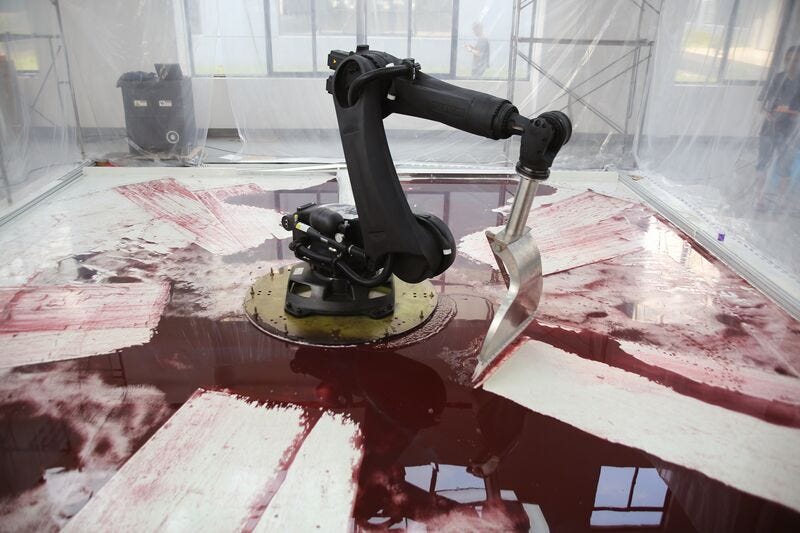Can’t Help Myself
What art can teach us about the nature of mental health conditions during the pandemic

It begins with you, the viewer, seeing an isolated figure performing a repetitive task, cleaning a blood-like fluid spread on the floor. There is no clear beginning, there is no clear end. It “cleans” one section (more like trying to hide it) and the fluid runs off in a wave like motion to another section where the figure can’t “see” it yet, trying to contain it while making a mess of its surroundings. It’s a beautiful mechanism of motion using a symbol of violence and intimacy. Blood is an intimate, personal, internal element of the subject related to identity and life, but outside the subject it becomes a vestige of violence. The work presumes an event, or series of events, that have lead to our current situation but these remain invisible. These are the first thoughts you might get when experiencing the artwork installation “Can’t Help Myself” (2016) by artists Sun Yuan & Peng Yu for the first time.
And while the installation was exhibited a few years ago at the Guggenheim Museum in New York and it clearly comes form another zeitgeist, I believe there are enough elements to create a new interpretation that might help us shed some light over the darkness of mental health conditions during what is now one of the longest-running and yet relevant events of our daily life, the pandemic.
The pandemic was caused due to a fast-spreading, people-ending, suffocating disease and the main response around the world to reduce the number of active cases and deaths was to fall into lockdown and isolation. This was of course the beginning of a new normality, a subject to memes, a common topic of conversation, a source of stress and an excuse to postpone social events you might have not wanted to go to. I myself thought it would only last about two weeks, yet here we are more than 52 weeks later. And while the COVID-19 situation might be very different from country to country and predicting how the next stage of the pandemic will play out exceeds my capabilities, I believe that it is in lockdown that we are exposed to another (rather silent) disease to which no vaccine will help us elude, we are exposed to a deteriorating mental health condition.
“Can’t Help Myself” illustrates this episode very well, a figure in isolation dealing with a problem that spreads all around and over which it has little to no real control of (only the illusion of it). An attempt to deal with this issue is normally an attempt to hide it (bringing the fluid back inside) but it cannot go back inside because it backfires in another way we can’t see right away. There is an element of empathy with the main character even when this is deprived from human aesthetics, because it behaves in a very human-like way, its vulnerability (which stems from the title) and inability of solving this problem is a situation we, as tech consumers, don’t see very often in machines. Yet there is also a demonstration of something machines excel at, repetition and work in continuous motion; something we can maybe start to recognize more and more in ourselves, in our humanity, during the pandemic world.
In a sense, we are all isolated entities with human and robot traits alike trying to hide our mental health conditions from viewers. Unable to help ourselves, vulnerable to the conditions of something that seems to go away and suddenly reappears in unexpected ways. This is where we come by the ultimate revelation of the artists, the title “I can’t help myself”. I can’t help myself out of this situation (i.e. I need help from others) and maybe I can’t help myself from falling into this loop again. I might have gotten very dark too fast, no worries. I believe there is greater lesson to be learned, everyone is dealing with issues that stem from what seems invisible circumstances to us viewers, people are like this sometimes.
Under the shared umbrella of current world events, where people have lost family members, friends, jobs, their daily lives. I think this can help us destroy some of the stigma surrounding mental health conditions. Maybe we can start considering ‘normal mental health’ as a goal rather than a default setting for people. And after all, why not use this time to develop some more empathy for those around us, even when we are a part. As I said, there is no such thing as a vaccine for mental health problems, but maybe we can do our part by making sure this disease doesn’t spread treating people with kindness and consideration above all.
I wanna use this last words to thank all the people who helped me during my mental health incidents, I feel free and inspired thanks to them <3
If you’re reading this, please consider subscribing to Away from the Flock. We’re an independent publication focusing on great pieces of literature, art, film and questions that are not commonly addressed in mainstream media.



